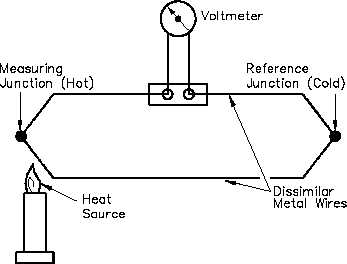THERMOCOUPLES
Temperature Detectors
Figure 5 shows the internal construction
Figure 5 Internal Construction of a
Typical Thermocouple
of a typical thermocouple. The leads of
the thermocouple are encased in a rigid
metal sheath. The measuring junction is
normally formed at the bottom of the
thermocouple housing. Magnesium oxide
surrounds the thermocouple wires to
prevent vibration that could damage the
fine wires and to enhance heat transfer
between the measuring junction and the
medium surrounding the thermocouple.
Thermocouple Operation
Thermocouples will cause an electric
current to flow in the attached circuit
when subjected to changes in temperature.
The amount of current that will be
produced is dependent on the temperature
difference between the measurement and
reference junction; the characteristics of
the
two
metals
used;
and
the
characteristics of the attached circuit.
Figure 6 illustrates a simple thermocouple circuit.
Heating
the
measuring
Figure 6 Simple Thermocouple Circuit
j u n c t i o n
o f
t h e
thermocouple produces a
voltage which is greater
than the voltage across the
reference junction.
The
difference between the two
voltages is proportional to
t h e
d i f f e r e n c e
i n
temperature and can be
measured on the voltmeter
(in millivolts). For ease of
operator
use,
some
voltmeters are set up to
read
out
directly
in
temperature through use of
electronic circuity.
IC-01
Page 6
Rev. 0



